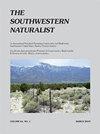PATTERNS OF WILDLIFE ACTIVITY AND PREDATOR-PREY DYNAMICS IN A HIGHLY TOURISTED AREA
IF 0.3
4区 环境科学与生态学
Q4 Agricultural and Biological Sciences
引用次数: 0
Abstract
Abstract Tourist activity in natural areas may impact species' behavior and ecology as well as predator-prey dynamics. Although previous research has demonstrated effects of human disturbance on wildlife communities, only a limited number of studies have focused on small mammals and coyote predator-prey systems. To generate an overview of human impacts on these wildlife communities, we analyzed camera trap data from a human-disturbed site at Lake Tahoe, California. To compare species' activity patterns in relation to distances from human-disturbed areas, we used single-species occupancy models, estimations of species' temporal activity overlaps, and the time between detections of different species at camera sites. We found that in general black bears (Ursus americanus) avoided areas of high human disturbance, whereas coyotes (Canis latrans), rodents, and lagomorphs favored them. However, rodents and lagomorphs also avoided areas with high coyote detections, indicating that rodents and lagomorphs mostly used human-disturbed areas that were not highly frequented by coyotes. Additionally, all aforementioned species avoided humans temporally and this avoidance increased in closer proximity to human-disturbed areas. These findings indicate that while some species frequented human-disturbed areas more than others, all species studied exhibited greater temporal avoidance of humans when closer to areas of higher human activity. Our results also indicate that rodents' and lagomorphs' activity patterns overlapped more with coyotes' activity patterns closer to human-disturbed areas and rodents and lagomorphs avoided coyotes less in these areas. The greater overlap of the species' activity patterns suggests that there is likely more interaction between coyotes and their prey closer to areas of high human activity. The changes in the behavior and ecology of wildlife communities closer to human-disturbed areas reported here emphasize how proximity to human-disturbed areas may influence both predator and prey demographics.在一个高度旅游地区的野生动物活动模式和捕食者-猎物动态
摘要自然区域的旅游活动可能会影响物种的行为和生态,以及捕食者-猎物的动态。尽管之前的研究已经证明了人类干扰对野生动物群落的影响,但只有有限数量的研究关注小型哺乳动物和郊狼捕食系统。为了全面了解人类对这些野生动物群落的影响,我们分析了加利福尼亚州太浩湖一处受人类干扰的地点的相机捕捉数据。为了比较物种的活动模式与人类干扰区域的距离,我们使用了单物种占用模型、物种时间活动重叠的估计以及在相机位置检测到不同物种之间的时间。我们发现,通常情况下,黑熊(美洲熊)会避开人类高度干扰的区域,而郊狼(北美犬)、啮齿动物和lagomorphs则喜欢它们。然而,啮齿动物和泻湖动物也避开了郊狼检测率高的区域,这表明啮齿动物和泻湖生物大多使用郊狼不常光顾的人类干扰区域。此外,上述所有物种都暂时避开了人类,而且这种回避在更接近人类干扰区域的地方增加了。这些发现表明,虽然一些物种比其他物种更频繁地出现在人类活动频繁的地区,但所有研究的物种在靠近人类活动频繁地区时,都表现出对人类更大的时间回避。我们的研究结果还表明,啮齿类动物和lagomorphs的活动模式与靠近人类干扰区域的郊狼的活动模式重叠得更多,而啮齿类动物在这些区域较少躲避郊狼。该物种的活动模式有更大的重叠,这表明在人类活动频繁的地区,郊狼与其猎物之间可能有更多的互动。这里报道的靠近人类干扰区域的野生动物群落的行为和生态变化强调了靠近人类干扰地区可能会影响捕食者和猎物的人口统计。
本文章由计算机程序翻译,如有差异,请以英文原文为准。
求助全文
约1分钟内获得全文
求助全文
来源期刊

Southwestern Naturalist
环境科学-生态学
CiteScore
0.50
自引率
50.00%
发文量
47
审稿时长
18-36 weeks
期刊介绍:
The Southwestern Naturalist (a publication of the Southwestern Association of Naturalists since 1953) is an international journal (published quarterly) that reports original and significant research in any field of natural history. This journal promotes the study of plants and animals (living and fossil) in the multinational region that includes the southwestern United States, Mexico, and Central America. Appropriate submission of manuscripts may come from studies conducted in the countries of focus or in regions outside this area that report significant findings relating to biota occurring in the southwestern United States, Mexico, and Central America. Publication is in English, and manuscripts may be feature articles or notes. Feature articles communicate results of completed scientific investigations, while notes are reserved for short communications (e.g., behavioral observations, range extensions, and other important findings that do not in themselves constitute a comprehensive study). All manuscripts (feature articles and notes) require an abstract in both English and Spanish.
 求助内容:
求助内容: 应助结果提醒方式:
应助结果提醒方式:


